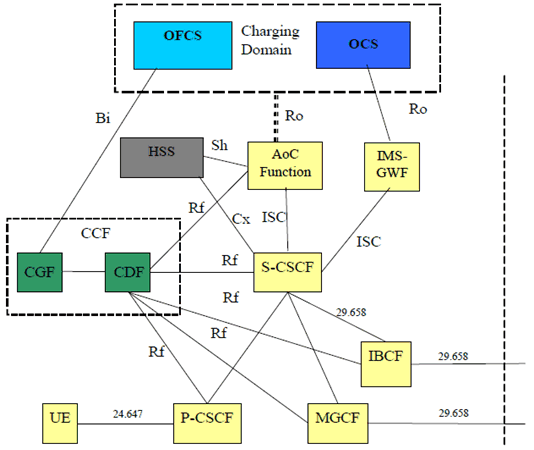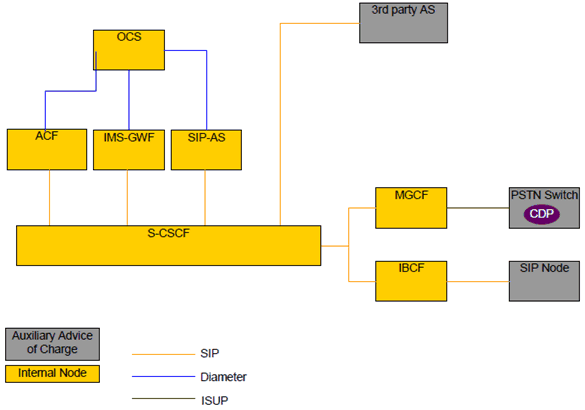Content for TS 32.280 Word version: 17.0.0
4 Architecture considerations
4.1 High level AoC aspects
4.2 AoC in GSM network architecture
4.3 AoC in IP Multimedia Subsystem (IMS) architecture
4 Architecture considerations p. 10
4.1 High level AoC aspects p. 10
Advice of Charge (AoC) is a user-specific supplementary service which provides AoC Information to the UE in real-time. It contains Cost and/or Tariff for the requested service, which may be provided either in monetary format (e.g. 0,10 €) or non-monetary format (e.g. 10 charging units).
Depending on the AoC service obligatory type (AoCI or AoCC), the provided information is either non-binding or binding. AoCI provides an estimation of the service Cost and/or Tariff which may deviate from the actual charges. In contrast to AoCI, AoCC is binding and shall correspond to the actual charges (e.g. corresponding bill position or amount which is deducted from the prepaid account).
The AoC service type depends on the following triggering events: AoC-S occurs at communication establishment and/or at tariff switch time. AoC-D is sent to the user during the communication, depending on predefined triggering conditions (e.g. to provide accumulated Cost for the ongoing usage every 5 seconds). AoC-E provides the total accumulated Cost of the service when the communication is released.
Any combination of the AoC service obligatory type and the service type may co-exist.
Online charging and offline charging and AoC services are mutually independent from the end user perspective.
The AoC Information may be based on Tariff Information from a local charging system, e.g. from an Online Charging System (OCS). Additionally, Tariff or Cost Information may be received from an external network or service provider in real time according to the Realtime Transfer of Tariff Information (RTTI) protocol defined in TS 29.658. This situation can occur in case of interconnection scenarios or 3rd party services like Service 0900. Depending on the local charging system indication, it may be decided whether external Tariff Information is either rejected or processed to create the AoC Information.
The selection of tariffs can be conditioned on any parameter defined in the charging information requirements mentioned in TS 22.115. The selection of tariffs may also be dependent upon and not limited to the Calling Party Category (CPC) defined in TS 24.229, the user balances, consumed resource prior or within the session, discounts, benefits or any other commercial agreement that the user is engaged with the service provider.
AoC-related subscription status and user profiles are stored in the HSS. The AoC-related user profiles contain the following information:
- AoC service obligatory type (AoCI or AoCC);
- AoC service type (any combination of AoC-S, AoC-D, and AoC-E);
- AoC configuration and preferences.
4.2 AoC in GSM network architecture p. 10
The CAMEL feature (Customised Applications for Mobile network Enhanced Logic) is described in TS 22.078.
The Charge Advice Information (CAI) is described in TS 22.024, TS 22.086, TS 23.086 and TS 24.086.
4.3 AoC in IP Multimedia Subsystem (IMS) architecture p. 11
4.3.0 Introduction |R11| p. 11
The IMS Charging Architecture is described in TS 32.260.
Figure 4.3.0.1 shows the specific part of the IMS charging architecture that handles AoC.

Figure 4.3.0.1 shows functional entities that are not directly involved in AoC, but completes the picture with affected interfaces.
TS 24.647 specifies the AoC Information transferred to the UE via involved IMS functional entities.
TS 29.658 specifies the procedures for the real-time transfer of charging information in interconnection scenarios.
AoC Function may reside in the same AS hosting the service for which the AoC Service is to be provided, or in a separate AS (not shown in Figure 4.3.0.1).
The AoC Function (ACF) requests the AoC-related subscription and formatting parameters from the HSS via Sh. Additionally, filter criteria for ACF triggering may also be retrieved from the HSS by a CSCF via Cx.
The AoC Function obtains tariff information from the charging domain via Ro or the AoC function may have local Tariff information available (see clause 4.3.1.1). See the AoC interfaces for details.
4.3.1 AoC functional entities p. 12
4.3.1.1 AoC Function p. 12
The AoC Function is a logical functional entity that provides AoC Information. It includes the following functions:
-
Receive and or obtain Cost / Tariff data from various sources:
- Charging domain
- External tariff received from an AACF in real time (TS 29.658)
- Locally configured data (valid only for AoCI service)
- AoC data determination - reworks and arbitrates how to combine the incoming Tariff / Cost sources.
- Transform the AoC data into the corresponding output message format for presentation.
4.3.2 AoC interfaces p. 13
AoC has the following interfaces:
Sh
for obtaining AoC-related subscription and formatting parameters from the HSS.
ISC
for receiving RTTI from Auxiliary AoC Function (AACF) and for providing the AoC Information to the UE.
Ro / Re
for obtaining Tariff and Cost Information; Ro shall be used for providing AoCC service and may be used for AoCI services.
AACF can be embodied in external nodes such as:
- Application Server
- Charging Determination Point (CDP) in a PSTN network
- SIP node in another IMS domain

4.3.3 AoC interworking with other features p. 14
4.3.3.1 AoC and offline charging p. 14
4.3.3.1.1 Interworking for AoC service execution |R10| p. 14
For scenarios where the ACF is interworking with the offline charging feature and the service obligatory type is AoCI estimating Cost and/or Tariff Information may be performed using any of the following methods:
- Local determination using offline synchronization of tariff information - The ACF may synchronize out of band the tariff information from the charging domain. In this case, the ACFneeds to have an independent rating function.
- Interactively via the CDF through Ro - ACF may obtain the tariff information interactively from the CDF.
- Interactively via the OCS through Ro - Offline subscribers can be perceived as online subscribers with unlimited balance (or very high balance that practically implies that). This approach enables the ACF to have unified flow of messages for offline and online subscribers in providing AoC Information.
4.3.3.1.2 AoC invocation recording |R10| p. 14
When ACF is triggered on behalf of a service and results in the AoC Information delivered to the UE, this ACF may also generate AoC related Rf messages as described in clause 6.3.1.3.
4.3.3.2 AoC and online charging p. 14
For scenarios where the ACF is interworking with the online charging feature and the service obligatory type is AoCI estimating Cost and/or Tariff Information may be performed using any of the following methods:
- Local determination using offline synchronization of tariff information - The ACF may synchronize out of band the tariff information from the charging domain. In this case, the ACF needs to have an independent rating function.
- Interactively via the OCS through Ro.
4.3.3.3 AoC and RTTI p. 14
The AoC service shall receive the Tariff or Cost provided in real time by the external network or service provider (e.g. interconnection scenarios or 3rd party services), according to TS 29.658. The AoC Information, provided to the UE, may take the provided information into consideration.